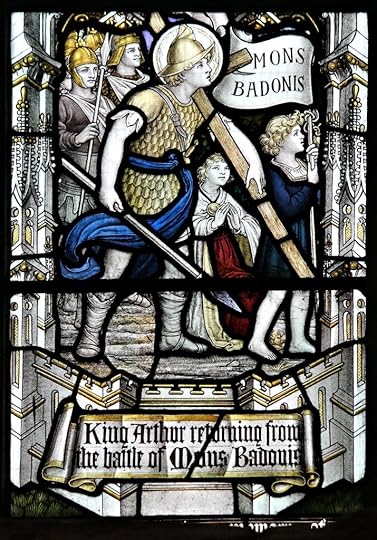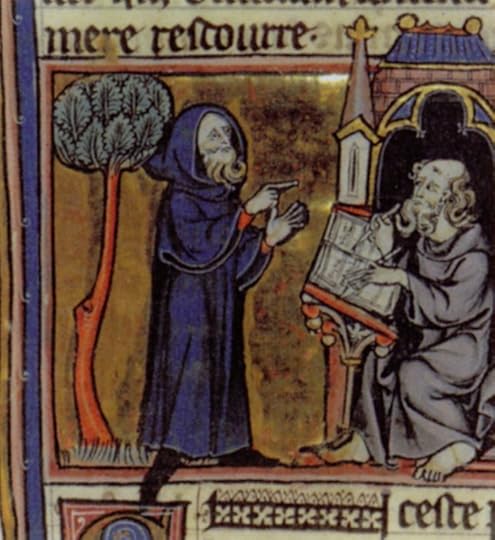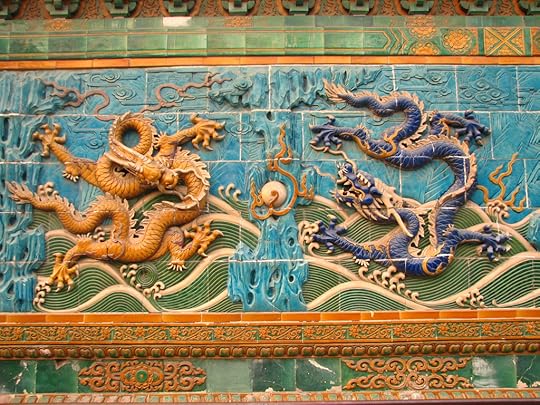Found sequel of Merlin and King Arthur
There likewise I beheld Excalibur
Before him at his crowning borne, the sword
That rose from out the bosom of the lake,
And Arthur rowed across and took it — rich
With jewels, elfin Urim, on the hilt,
Bewildering heart and eye — the blade so bright
That men are blinded by it — on one side,
Graven in the oldest tongue of all this world,
“Take me,” but turn the blade and ye shall see,
And written in the speech ye speak yourself,
“Cast me away!”
Alfred, Lord Tennyson, Idylls of the King, The Holy Grail
 The Story of King Arthur and his Knights by Howard Pyle (1902)., Public Domain, https://commons.wikimedia.org/w/index.php?curid=1878115
The Story of King Arthur and his Knights by Howard Pyle (1902)., Public Domain, https://commons.wikimedia.org/w/index.php?curid=1878115The tales of King Arthur, Guinevere, Lancelot and Merlin the Sorcerer rise from the mists of early Britain, steeped in ancient magic and mayhem.
Arthur, or Artorius, is speculated to have been an actual historic figure in 5th or 6th century Britain, which, after the departure of the Roman conquerors, was divided between a number of fractious factions that fought incessantly. Under threat of invasion by Anglo-Saxons, however, Arthur was able to unite the kingdoms into one and lead them to victory in the Battle of Badon. This battle is accepted as historical fact. The rest is all legend.
 King Arthur returning from the Battle of Mons Badonis (or Mount Badon). First reference to Arthur, found in early Welsh literature. Stained glass in Llandaf Cathedral, Cardiff. By Llywelyn2000 – Own work, CC BY-SA 4.0, https://commons.wikimedia.org/w/index.php?curid=48360828
King Arthur returning from the Battle of Mons Badonis (or Mount Badon). First reference to Arthur, found in early Welsh literature. Stained glass in Llandaf Cathedral, Cardiff. By Llywelyn2000 – Own work, CC BY-SA 4.0, https://commons.wikimedia.org/w/index.php?curid=48360828The story really begins with the birth of Merlin, said to be a “cambion”, an old word for the child of an incubus demon and a human woman (in this case a nun, the daughter of the King of Dyfed). (Those darned incubi, they loved to corrupt religious virgins.) Born with the ability to speak like an adult and a variety of supernatural skills, baby Merlin is tainted by his bloodline and is destined to become a version of the Antichrist, until he’s baptized by a priest named Blaise and freed from the influence of Satan.
Merlin has knowledge of the past, present and future. When Uther Pendragon, king of all Britain, develops the hots for Igraine, the lovely wife of Gorlois, the Duke of Cornwall, he asks Merlin to use his magic to help Uther seduce her. Merlin agrees, for a price:
“this is my desire: the first night that ye shall lie by Igraine ye shall get a child on her, and when that is born, that it shall be delivered to me for to nourish there as I will have it; for it shall be your worship, and the child’s avail, as mickle (very large) as the child is worth.”
Sir Thomas Malory. Le Morte d’Arthur: Volume 1
 The Birth, Life, and Acts of King Arthur, of His Noble Knights of the Round Table, Their Marvellous Enquests and Adventures, the Achieving of the San Greal and in the End Le Morte d’Arthur, with the Dolorous Death and Departing Out of This World of Them All, two volumes. First Beardsley edition of Malory’s Arthurian epic, vellucent binding by Cedric Chivers, hand-painted after Beardsley’s own artwork within. London: J. M. Dent, 1893. Large square octavo (240 × 192 mm). By Cedric Chivers / Aubrey Beardsley – https://pictures.abebooks.com/inventory/30649265604.jpg, Public Domain, https://commons.wikimedia.org/w/index.php?curid=119265094
The Birth, Life, and Acts of King Arthur, of His Noble Knights of the Round Table, Their Marvellous Enquests and Adventures, the Achieving of the San Greal and in the End Le Morte d’Arthur, with the Dolorous Death and Departing Out of This World of Them All, two volumes. First Beardsley edition of Malory’s Arthurian epic, vellucent binding by Cedric Chivers, hand-painted after Beardsley’s own artwork within. London: J. M. Dent, 1893. Large square octavo (240 × 192 mm). By Cedric Chivers / Aubrey Beardsley – https://pictures.abebooks.com/inventory/30649265604.jpg, Public Domain, https://commons.wikimedia.org/w/index.php?curid=119265094Uther is so filled with lust that he agrees. Merlin then transforms Uther into the likeness of Igraine’s husband, and himself and one of Uther’s men into the appearance of knights already at the castle of Tintagel. The magic works, Igraine sleeps with Uther, and the child who would be a future king – Arthur – is born.
The rest of the story has been told and retold many times over the centuries, and in modern times in movies and television series. It’s compelling legend – Merlin’s raising and mentoring of the boy into the man, Arthur’s gifting of the magical sword Excalibur by the Lady of the Lake, his marriage to Guinivere, the building of Camelot and the formation of the Round Table, Guinivere’s tragic affair with the noble Lancelot, and much more that’s been romanticized and embellished by several medieval authors. Personally, I think the 1981 movie Excalibur, by John Boorman, is a fantastic recreation of the times and the legends.
In the end, King Arthur is mortally wounded by his own ambitious son, Mordred (with a name like that, how could he not be evil), returns the sword to the lake, and is taken to the mystical Isle of Avalon, his final resting place … until Britain should need him once again.
Merlin enters a cave and falls into an endless sleep, awaiting the return of Arthur.
 Medieval image of Marlin. By Unknown author – Scan from “Brockhaus Geschichtslexikon, vol. 2, Mittelalterliche Welt und frühe Neuzeit”, article “Geoffrey of Monmouth”, earlier uploaded to de.wikipedia. Originally in Histoire de Merlin by Robert de Boron), Public Domain, https://commons.wikimedia.org/w/index.php?curid=310472
Medieval image of Marlin. By Unknown author – Scan from “Brockhaus Geschichtslexikon, vol. 2, Mittelalterliche Welt und frühe Neuzeit”, article “Geoffrey of Monmouth”, earlier uploaded to de.wikipedia. Originally in Histoire de Merlin by Robert de Boron), Public Domain, https://commons.wikimedia.org/w/index.php?curid=310472I think it’s the idea that King Arthur might one day return that makes the story so powerful, and so enduring – that the greatest king in history is waiting to save the world again, and that the most iconic wizard of legend will be by his side. Driving around England, watching the mists roll down the hills, it’s easy to get swept up into the romance of it all. ‘King Arthur’ tours can be taken by dedicated fans, advertising “More than a myth or legend, King Arthur’s legacy is an adventure to be explored. Visit places in Bodmin and the rest of Cornwall that are central to stories about his life, and learn about where he lived and died. Visit Tintagel Castle and Merlin’s cave, and see the waterfalls at Nectan Glen where the knights of the round table were blessed before their quest for the holy grail.” The Legend of King Arthur tour on Viator
Imagine the excitement when an archivist in Cambridge University Library recently found a 700-year-old fragment of an Old French manuscript that expands the tale of Merlin, stitched into the binding of a 16th-Century register of property deeds. In Elizabethan times it had been repurposed as a book cover.
To avoid cutting the binding, library staff used CT scanning, multispectral imaging (MSI) and 3D modelling to access even folded parts of the fragment and enhance heavily faded areas of text.
In the further adventures of Merlin, he becomes a blind harpist, disappears into thin air, then reappears as a balding child who, for some reason, issues edicts to King Arthur without underwear on. He then asks to bear Arthur’s standard (a flag with his coat of arms) on the battlefield, and turns up with a magical dragon to breathe fire at the enemy.
More legend to add to the canon. Or is it?
 The Nine Dragon Wall in the Beihai Park, a large imperial garden in central Beijing. By splitbrain – Nine Dragons Wall detail in Behei Park, CC BY-SA 2.0, https://commons.wikimedia.org/w/index.php?curid=4881134
The Nine Dragon Wall in the Beihai Park, a large imperial garden in central Beijing. By splitbrain – Nine Dragons Wall detail in Behei Park, CC BY-SA 2.0, https://commons.wikimedia.org/w/index.php?curid=4881134We might ask if things like dragons ever existed, for example. I hope they did, that there was a time when magic permeated the world. There’s no evidence that dragons were real, other than numerous ancient writings.
“For using dragon’s bones, first cook odorous plants; bathe the bones twice in hot water, pound them to powder and put this in bags of gauze. Take a couple of young swallows and, after taking out their intestines and stomach, put the bags in the swallows and hang them over a well. After one night take the bags out of the swallows, rub the powder and mix it into medicines for strengthening the kidneys. The efficacy of such a medicine is as it were divine!”
–Chinese medical scholar Lei Xiao (AD 420-477)
The magic of the Merlin and King Arthur story is the magic, the idea that wonderful and mystical things existed in our world once upon a time. It’s an idea that’s particularly powerful in the 2000s.
 The_last_sleep_of_Arthur.jpg By Edward Burne-Jones – http://www.illusionsgallery.com/Arthur-avalon.html via English Wikipedia, Public Domain, https://commons.wikimedia.org/w/index.php?curid=859465
The_last_sleep_of_Arthur.jpg By Edward Burne-Jones – http://www.illusionsgallery.com/Arthur-avalon.html via English Wikipedia, Public Domain, https://commons.wikimedia.org/w/index.php?curid=859465The magic of the discovery lies in the remarkable techniques used to read the uncovered story. The university used Computed Tomography (CT) scanning to digitally penetrate the layers of parchment. It provided a 3D model of the fragment and the structure of the binding without dismantling the book. As a bonus, the scan also gave insight into 16th-century archival binding techniques.
Scans were able to create a 3D model of the manuscript using mirrors, prisms and other tools to photograph each section, some of which were either stitched into the binding or hidden inside folds, and then digitally assemble those so that the document could be read.
After all that, the team had to get past the wear on some of the fragments. They exposed the manuscript to light in different wavelengths to improve the readability of the text, and even highlight notations made in the margins.
This is considered a major find, which the Cambridge U researchers went to a great effort to recover. The pursuit of storytelling at its finest.



